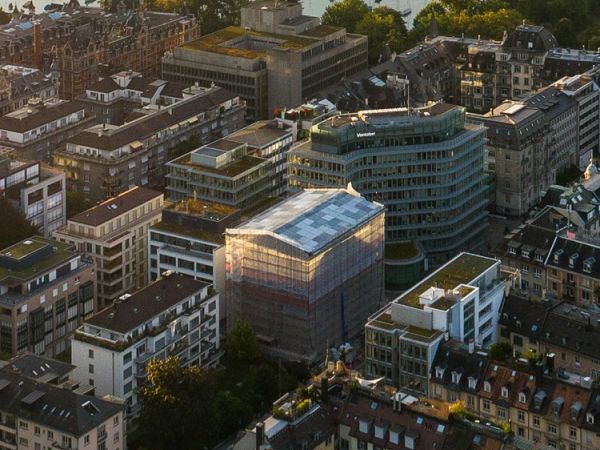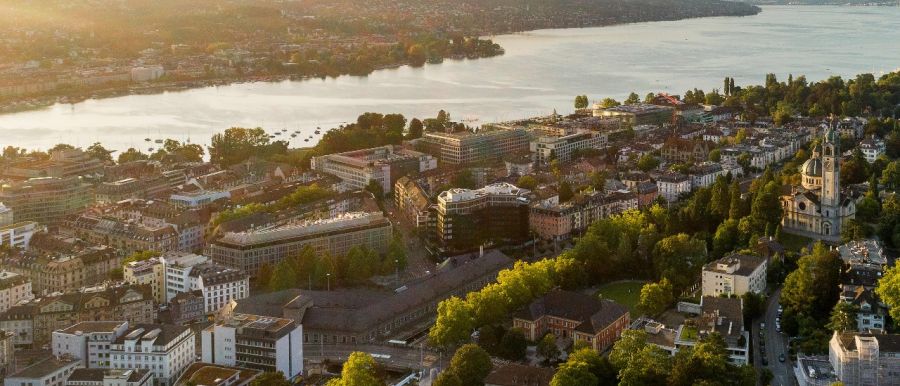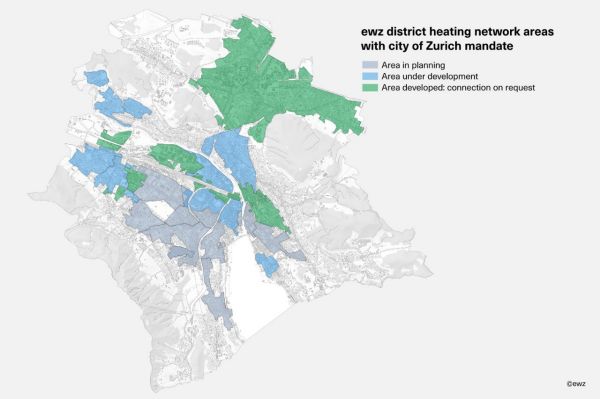

The milestones provide an overview of the planned and realised construction projects for the city of Zurich’s climate-friendly heating supply transformation. They point to important political decisions taken as a result of referendums.
With a third incineration line and optimisation of the existing infrastructure, the incineration plant is able to supply double the amount of thermal energy. This enables ewz to expand the district heating networks in Zurich and supply more buildings with climate-friendly heat in the future.
The Altstetten and Höngg energy network is one of the projects with an impact far beyond Switzerland’s borders. In its final state, the network will supply around 30,000 households with climate-friendly heating and, in some cases, cooling. To this end, the future energy centres in Herrlig and Rautistrasse will be connected via underground anergy pipes installed in a microtunnel.
The future is under construction at Basteiplatz. Here, ewz is building the access point for the small microtunnel, which will run to the target excavation pit near Bürkliplatz. The aim of the tunnelling is to connect the existing Fraumünster lake heat network with CoolCity in the future. Upon completion, CoolCity will supply approximately 500 buildings in the supply area with heating and cooling using the lake’s water.
By 2027, around 120 properties in the popular Seefeld residential and business district will be connected with renewable heating and cooling. The Riesbach energy centre on the campus of the EB Zurich cantonal vocational school is at the heart of this network and is due to be commissioned in summer 2024.
A 6.5 km long hot water pipeline connects the district heating regions of Zurich North and Zurich West to make climate-friendly energy available for new district heating areas as well. Until spring 2021, the Josefstrasse site was home to Switzerland’s first waste incineration plant, which also supplied the country’s first district heating network. The plant is now being converted in stages into an energy distribution and storage centre for areas in the urban core.
An innovative solution for a comprehensive heating supply system with lake water was found by sinking the pumps into the lake. This made it possible to expand the Fraumünster lake heat network to supply the Zurich Stadthaus, the Haus Bellevue and other buildings on Fraumünsterstrasse and Paradeplatz/Bahnhofstrasse. The Fraumünster church also benefits from the sustainably produced heating and cooling.
With the reopening of the Convention Center, the energy centre for the Escherwiese lake heat network was also put into operation. In addition to the Convention Center, this supplies the Park Hyatt hotel and various other office buildings on Bleicherweg and Claridenstrasse with environmentally friendly heating and cooling. Lake water from a depth of 12 metres is used as the energy source for the combined heat pumps and cooling machines and is transported via a 250-metre pipeline to the energy centre in the Convention Center.
The Altstetten and Höngg energy network is a flagship project for the environmentally friendly energy supply of the future. For the connection of the Werdhölzli sewage treatment plant to the planned transmission network in Höngg to the north, flush drilling was used to create an underground connection beneath the Limmat River between the sewage treatment plant site and Höngg.
From January 2025, ewz will take over ERZ’s district heating areas, creating the largest district heating network in Switzerland. The renewable energy sources include lake water, wood and waste heat from sewage treatment plants and waste incineration plants. Today, district heating networks cover a good third of the city of Zurich‒ with that figure expected to rise to around 60 per cent by 2040.
From January 2025, ewz’s district heating network in the city of Zurich will cover around 250 km.
By 2040, ewz’s district heating network in the city of Zurich will grow to around 400 km.
At ewz, more than 7,500 properties are currently connected to the district heating network in the city of Zurich.
The history of district heating goes back a long way. As early as the 1970s, waste heat from waste incineration was used in the city of Zurich. Since 2000, we have been supplying district heating from renewable sources, such as lake water and waste heat from treated wastewater. Today, district heating networks cover a good third of the city of Zurich ‒ with that figure expected to rise to around 60 per cent by 2040.
Use the district heating information tool (in German) to check whether it’s possible to connect to a district heating network. There is no requirement to connect. Find out more about our heating network solutions.

District heating is infrastructure that supplies thermal energy to several buildings on different plots of land. This is transferred as water or steam in insulated pipelines from one or more energy centres (generators) to the connected buildings (consumers). Thermal network, district heating/cooling network and energy/heating network are related terms. District heating networks can be supplied from various sources and, depending on the design, offer the option of supplying buildings with heating and cooling.
By using locally available renewable energy sources, you’re helping to reduce carbon emissions. In addition, you’re meeting current and future energy policy requirements. One possible source is waste heat from sewage treatment plants or technical facilities such as data centres. In addition, wood, groundwater and lake water can be used as sources of heating and cooling for thermal networks. All of these energy sources are renewable and locally available, so they don’t have to be imported.






